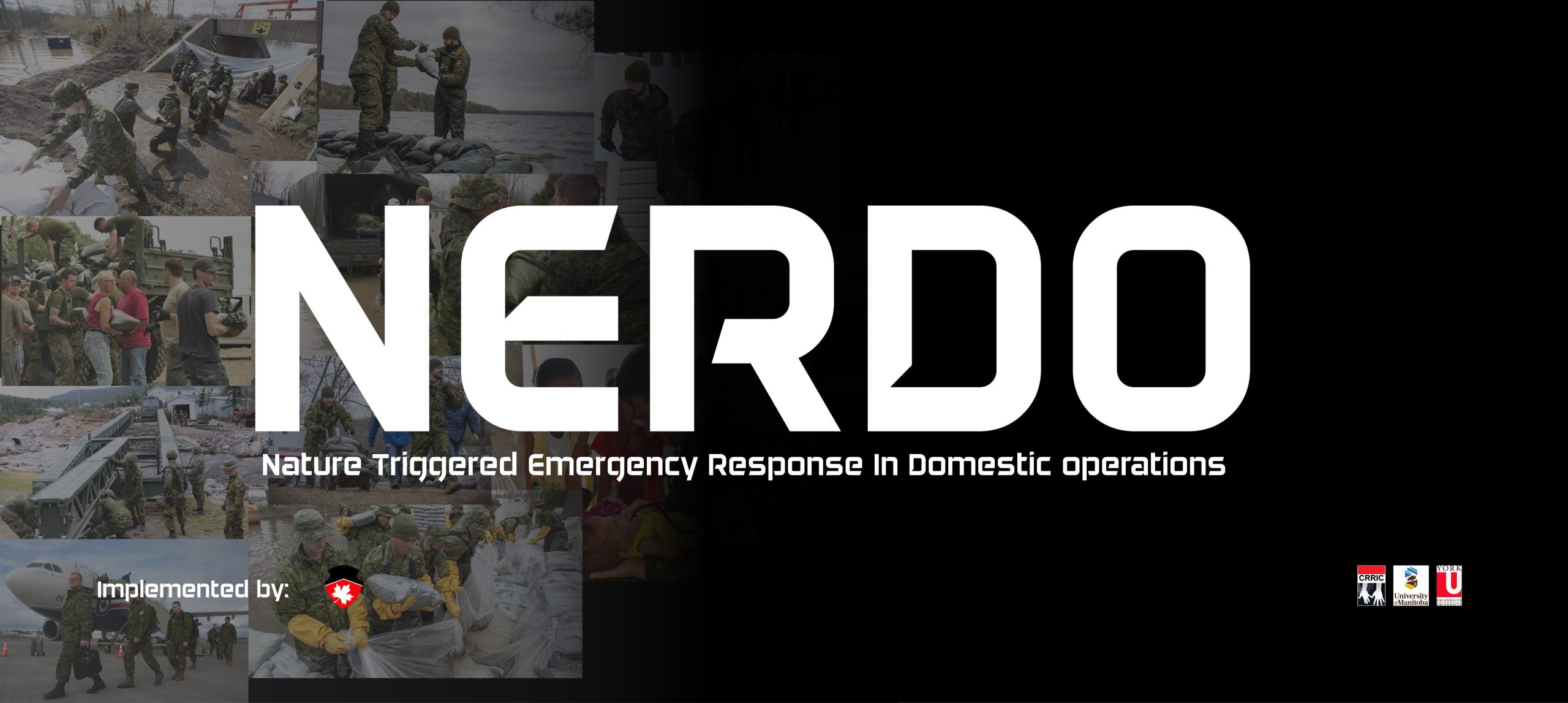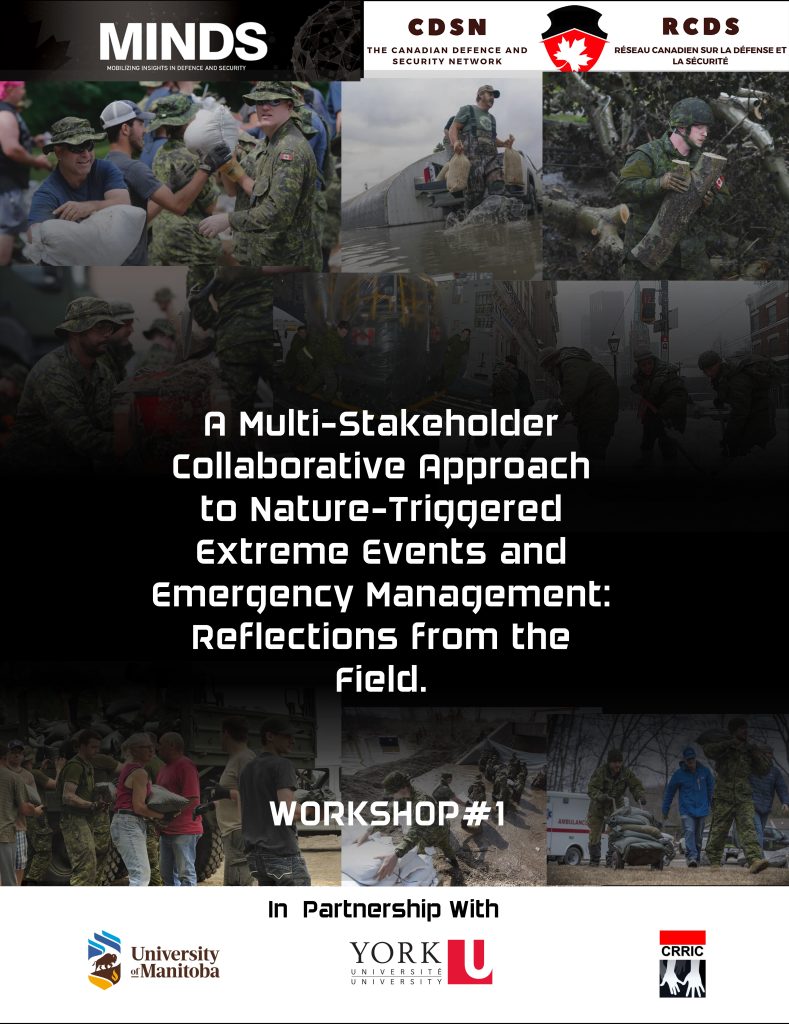

Previous events

A Multi-Stakeholder Collaborative Approach to Nature Triggered Emergency Management: Reflections from the Field
wORKSHOP#1
Mobilizing Insights in Defense and Security (MINDS) workshop #1 on “A Multi-Stakeholder Collaborative Approach to Naturally Triggered Emergency Management: Reflections from the Field,” funded by the Centre for Defence and Security Network (CDSN) and organised by Conflict and Resilience Institute Canada (CRRIC), took place in the Canadian Museum of Human Rights in Winnipeg on December 5th and 6th, 2022.
In the one half-day event, the first day was allocated for the speakers to share their insights and ideas regarding nature-triggered events and military involvement during nature-triggered emergencies, and the second day was allocated for discussion by the participants, speakers, and presenters. The speakers were Professor Stephen Sideman, Joanu Botha, Dr. Christopher Ankersen, Major N.C.G. (Nate) Maladrewicz, Gilbert Fredette, Dr. Etsuko Yasui, Dr. Danny Blair, and Professor Jodi Manz-Henezi, Professor Dr. C. Emdad Haque, and Professor Dr. Nirupama Agarwal. Professor Dr. Kawser Ahmed, who is also an adjunct professor at the University of Manitoba (NRI), moderated the workshop.
Professor Stephen Sideman started the event with his speech by recalling the military involvement during COVID and the role of the military. He also added that it is a period of climate crisis, and the role of the military cannot be undervalued. He thanked the team for organising such an event.
Dr. C. Emdad Haque delivered his welcome speech where he followed the reverse pyramid approach where he first talked about the disaster trends worldwide, then showed the situation in Canada, and gradually broke it down to damage and loss by disaster as well as the burden of the disaster at different levels. The most important thing to learn from his speech was the need for a civil-military institutional arrangement that can adapt quickly to the changing situation on the ground and the necessity of creation of a federal disaster response agency that is not part of the military.
Dr. Nirpupama in her welcome speech focused on the conflict and debates about military involvement in disasters. In her speech, she brought up a big reason why the study is being done: disasters are happening more often, and the military is playing a bigger role in them. What can be done about this? Should it be the new normal to involve the military, or should other resources be found to make people less dependent on the military?
Dr. Christopher Ankersen, the keynote speaker of the event, shared his experiences in the 1997 Red River Flood, including how they collaborated with the civil authority and the puzzling episodes of the event. Disaster management is a political matter, and there are a set of rules that the Canadian Armed Forces need to follow. He addressed the conflicts and issues associated with military deployment. He questions, what are the blurred lines between military and civil response? Should the response be treated as a normal event, or should the military make responding part of their job?
Major N.C.G. (Nate) Malazdrewicz from the Canadian Armed Forces introduced the organisational structure of the military and broke down the activities of the armed forces, where the response to disasters falls under “Combat Service Support” activities. The Canadian Armed Forces are distinguished from other responders by their organised labor, resources, and specialised capabilities.
In the event, we had one special guest, Gilbert Fredette, from the indigenous community of the Norway House project. He added new dimensions to his presentation by discussing the Reserve Detainment Act of 1867, broken treaties, and the relationship between indigenous communities and disasters. Then he gave a view of vulnerability through the lens of indigenous disasters. challenges faced by the community and the first nation’s safety disaster plan with the case study of the Norway House Cree Nation.
Prof. Dr. Etsuko Yasui built on what the last speaker had said, focusing on how communities can recover from disasters and how vulnerable they are. She used the “reverse pyramid” strategy, moving slowly from the lowest level to the highest level. Disaster recovery was the main topic of conversation in terms of rebuilding better and making people less vulnerable. She also talked about how the military could step in as a last resort when emergencies happen every day. She also set up a culture of working together and a new way of seeing disasters as opportunities.
Joanu Botha, Assistant Deputy Minister, Manitoba Emergency Measures Organization (EMO), gave the unique presentation of the day, where he compared effective inter-organisational collaboration with full-course meal preparation. He compared emergency management to full-course meal preparation because, unlike meal preparation, in emergency management we have many elements that will prepare a perfect outcome, and there are many dos and don’ts as well.
Dr. Danny Blair used evidence to discuss the naturally occurring event and its implications. According to him, disaster is a powerful motivator, and businesses and organisations need to increase their resilience to cope with upcoming disasters. Because data shows that as climate change continues, disasters will increase. We must increase our coping capacity with the situation. With his insightful presentation, the workshop for day 1 ended.
On the second day of the event, Professor Jodi Manz-Henezi presented on the need for emergency management professionals. She discussed the disasters and how the future of events would be much larger, requiring more and more professionals in the field. She also discussed the organisations involved in emergency management in Canada. The institutes involved in making future emergency managers and how programs will introduce a new perspective on looking at disasters.
After her presentation, the floor was open for discussion, and the participants talked about their views. Major General Dennis Tabbernor also joined the discussion, where he focused on decision-making as a crucial element during disaster response as well as the understanding between civil and military authority that is needed. The participants discussed disaster and gender issues, multipurpose organizations, financial issues, power structures, sustainable approaches to disasters, strengthening local institutions, and uncertainty and disaster-induced migration. The presenters and speakers were present, and they also participated and talked about the topics raised by the participants.
The two-day event ended with the commencement of the upcoming workshop in Toronto in March, 2023, and a proposal was put on the table to organise a disaster exercise in Winnipeg. The workshop provided a lot of insights and information that gave food for thought.
